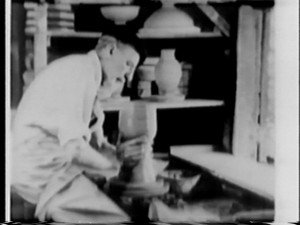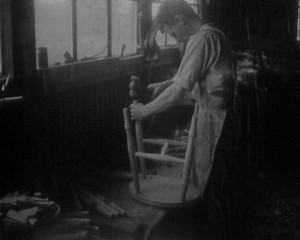"Among the ten best, Century of Progress, in Kodacolor, by Herbert H. Johnson, ACL, is a striking illustration of the degree of perfection that color motion picture photography has attained. Its studied angles and dignified composition are augmented by excellent photography. Mr. Johnson paid careful attention to the very important point of exact exposure in relation to color value and, as a result, brought a new version of the Fair to the one who had never seen it in color before. By taking plenty of time he was able to single out the best camera positions and wait for the lighting that was most favorable. The excellent handling of the camera brought a sense of intimacy to each scene. The film's only fault is an excessive use of lap dissolves which detracted somewhat from the smoothness of the continuity." Movie Makers, Dec. 1933, 499.
"A Century of Progress, the one reel record of the Fair in Kodacolor, by Edmund Zacher, II, ACL, is distinguished by the freshness of its dramatic treatment rather than by the faultless excellence of technique. In this latter field, Mr. Zacher, choosing to experiment along relatively unblazed color trails (slow motion, night photography, dissolves, etc.) has on occasion made slight errors, a fact which he himself is the first to admit. Dramatically, however, his film is a joy and a delight, replete with human interest, unhurried but unflagging in its presentation of the Fair from ever fresh viewpoints." Movie Makers, Dec. 1933, 523.
"doc. didattico"/educational documentary

"Ceramics, by Kenneth V. Bloomer, ACL, and Elizabeth Sansom, ACL, is probably the most ambitious amateur film ever attempted on this particular subject and perhaps stands alone in its field. The makers of the film were fortunate in having the cooperation of a famous ceramic artist, Leon Volkmar, who maintains his atelier at Bedford Village, N. Y. It was here that the entire film was produced, its makers having imbibed the spirit of the artist craftsmen so thoroughly that every deft touch, every careful step in the process of making a lovely vase are recorded. The interior lighting and closeup technique are especially good, particularly in those parts where only the delicate focusing of a closeup will reveal the nuances of the artist's touch as he models. The sequences which show the firing of the pottery are unusually well handled and the whole is outstanding in its clarity of continuity. Such a film might be described as a "glorified industrial" but, more than that, it is an educational film in the best sense of the word." Movie Makers, Dec. 1933, 499-500.

"The production of components for chairs is compared and contrasted at three locations in the Chiltern Hills" (EAFA Database).
Film showing Charlotte Laverents on a balloon ride. The film shows the balloon's flight through still photographs that Charlotte took while on the balloon.
documentario "sull'avioraduno universitario di Bologna, svoltosi alla presenza del Duce"—Littoriali del cinema, Merano, 1939
documentary "on the air rally of the University of Bologna, held in the presence of the Duce"-Littoriali del cinema, Merano, 1939
"'Chicago the Vacation Center of the Nation,' which was awarded the honors in the Documentary class, was photographed in 16mm. color by Theodore D. Shaw of the Metro Movie Club of Chicago. Mr. Shaw has been making movies for eight years, which fact perhaps explains why he was able to accomplish what he did without the use of filters or other effects. The film gives an excellent portrayal of life in a big town, starting with the day as Chicago appears at sunrise. Perhaps it would be difficult to name a city which possesses so varied a background in its lake and river and bridges. Certainly educational authorities searching for subjects that portray with authenticity life in metropolitan centers could not go wrong in seeking this fine picture of Chicago. The subject rates in all departments as a finished film." American Cinematographer, Jan. 1939, 17.
"Documentary: Depicts lives of children in the Belgian Congo and French Cameroon." National Archives.
"Excellent documentary of the care and treatment of (cerebral palsy) spastic children. The very thought of the subject may bring us sharply to the realization of our good fortune. The picture handles the subject with fine touches of human interest and may cause us to feel thankful that there are those who will devote their time and energies to this work. It must be tremendously rewarding to see the children learn to walk and do things under their own power and control. A truly enlightening picture" PSA Journal, Nov. 1959, 48.
Total Pages: 79